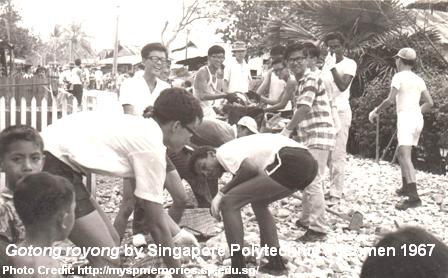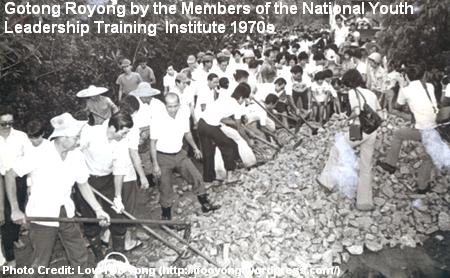The phrase “kampong spirit” has been mentioned frequently in recent years, especially in the media or used by the community leaders in their speech. Another phrase “gotong royong“, a term widely used in the sixties and seventies but relatively unknown to the younger generations, is also occasionally making its rounds, most notably by current Prime Minister Lee Hsien Loong at a book launch at Kampong Radin Mas early this month.
Definition of Gotong Royong
So what is gotong royong? Originated from Indonesia, the phrase is translated into English as “cooperation in a community” or “communal helping of one another”, but the closet interpretation is perhaps “mutual aid”. Gotong royong involves the spirit of volunteerism, and working together for the benefits of the residents living in the same community. It promoted a selfless approach that proved beneficial to the building up of cultural identity among the people.

Community Spirit in Other Countries
In other parts of the world, the promotion of community spirit has been a social policy for many governments. It takes on many names such as gadugi (Native American), talkoot (Finnish), bayanihan (Filipino), harambee (Kenyan), imece (Turkish) and meitheal (Irish). For centuries, the dream of building an idealistic society, otherwise known as the utopia, was heavily sought after, but often resulted in catastrophic failure when the method used was too extreme. China’s state policy (in 1958) of a peoples’ commune, where everything from kitchens and tables to farms and food were shared and distributed among the people, was one of the examples.

In Southeast Asia, nationalism was on the rise after the Second World War. Indonesia’s first president Sukarno actively pursued the idea of gotong royong as a way of Indonesian life in a newly-independent nation. In Malaysia, gotong royong was embraced as part of a collaborative practice in the Malay traditions and customs, and was even determined as one of the important socio-economic values in its National Cultural Policy in 1973.
Gotong Royong in Singapore
Singapore of the sixties and seventies provided the ideal environment for the growth of the spirit of gotong royong. Fresh from independence, Singapore was struggling with its economy and national identity.

The horrors of bus strikes and school riots appeared vivid in the people’s minds, and the racial tension was still high. The rural areas, though, were relatively more peaceful and harmonious. Residents living in multi-racial villages continued to look out for each others in the turbulent years.
The kampong spirit was more than just little aspects of daily life such as borrowing a few pinch of salt and a couple of eggs or sharing a dish. The neighbours were able to share and help out one another based on trust and friendship, forging bonds and strong ties within the community.

Gotong royong, on the other hand, was promoted through the voluntary works by the national servicemen, students and committee members, that included clearing paths, paving roads, filling up potholes and repairing houses that were damaged by thunderstorms or floods. The filth and stench might put off, but majority of the volunteers would be touched by the overwhelming appreciation and gratitude shown by the kampong residents.
Time Changes
As Singapore began to ramp up its public housings and new townships in the late seventies, many residents living in the kampongs were resettled at the new HDB flats. The government tried to encourage the practice of neighbourhood watch, as the flat owners now lived closely to one another, shared by the long common corridors. It could be considered an alternate form of community spirit, but even so, the spirit was gradually diluting as time passed.
Dubbed as one of the four Asian tigers (or little dragons), Singapore was enjoying its high growth and economic success in the eighties and nineties. The standard living of an average Singapore family improved, and a younger generation of competitive Singaporeans began to pursue the so-called materialistic 5C dream (Cash, Car, Credit card, Condominium and Country club membership). Long hours of work resulted in lesser interactions between neighbours; every family became contended to live in their cozy worlds behind closed doors.
As Singapore entered into the new millennium, the society geared up its competitive nature and focused more on results and profits. This did create a more efficient system, but it also widened the gaps between the people. More became self-centred and individualistic. The massive influx of foreigners further divided the society. For the first time since independence, Singapore’s own unique culture and identity, forged and strengthened through decades of nation building, faced the risks of dilution.
We will then have to ask ourselves: can the kampong spirit and gotong royong spirit be truly revived again?
Published: 17 September 2013








Hi Maureen.
Here’s an article.
http://infopedia.nl.sg/articles/SIP_1773_2011-03-25.html
And pictures
http://www.singas.co.uk/HTML/singapore_in_the__60s.html
More articles
http://goodmorningyesterday.blogspot.sg/2007/07/our-history-goes-back-further-than-that.html
I grew up in a HDB flat but was fortunate enough to experience gotong royong at work. Parents trusted our neighbours and would often leave our house keys with neighbours so that we can collect from them when we returned from school.
From my experience in grassroots work in a mature estate, the kampong spirit is very present, especially amongst the older residents who moved into HDB flats from the kampongs.
Have to admit gotong royong is gradually dwindling. All the more important that we continue to create opportunities to boost the flagging kampong spirit.
There is a small road, off Upper Paya Lebar Road, named Jalan Gotong Royong. It was named after the spirit of gotong royong 🙂
Archive of the news:
S’pore needs ‘gotong royong’ spirit to do well: PM Lee
Channel NewsAsia, 1 Sep 2013
Prime Minister Lee Hsien Loong has said the strong community spirit present in kampongs should still be maintained today for Singapore to do well. Mr Lee made these comments at a book launch, specially held for former residents of Kampong Radin Mas.
Kampong Radin Mas is believed to be among the oldest villages in Singapore. While it was the birth place to many Malay-Muslim institutions, Mr Lee said it also produced leaders who made important contributions in politics, as well as in arts and culture.
He asked: “How did Radin Mas produce so many talented people? Some people said it’s because of the ‘air pancur’ – the spring water, which flowed from Mount Faber to the kampong. Others said maybe it was the ice ball kacang, or the kuti kuti and the kana. All the sights and sounds and colours and activities of the old kampong.
“But everybody agrees that the ‘gotong royong’ spirit had a lot to do with it, where people help one another, where everybody knew everyone else and each spurred the other to go on and do their best.
“Even today, when we are in HDB flats – much bigger towns, not a few hundred people, but hundred thousand people perhaps – it’s still necessary for us to maintain that strong community spirit for us to do well.”
The book “A Village Remembered: Kampong Radin Mas 1800s To 1973” documents life in Radin Mas village before it was demolished in 1973 to make way for a satellite town. The book recounts the origins of the village, famous landmarks in Radin Mas and even has some ghost stories. It also gives some examples of how the community worked together.
Former Minister of Social Affairs Othman Wok said: “I remember this old man. He used to come to sell things in the kampong and one day after the rain, he slipped and fell down. All his things went all over the place. So the people laughed. They thought it was very funny. But not my mother – she came down and helped the hawker to take all his things, wash everything, and he was very grateful.”
The government said one way the community spirit can be re-invented today is through common amenities. Dr Yaacob Ibrahim, Minister for Communications and Information and Minister-in-charge of Muslim Affairs, said: “I think this is something for us to think about as we go forward, as we build the new Singapore.
“How do we build communities is an important point as we bring people together. I suppose HDB, our land agencies, would have to think about it very carefully. It is nice to build nice buildings, but I think it is also the facilities which are important, where people can come and congregate.”
The book is based on historical documents and interviews with former and current residents.
At Punggol Waterway…